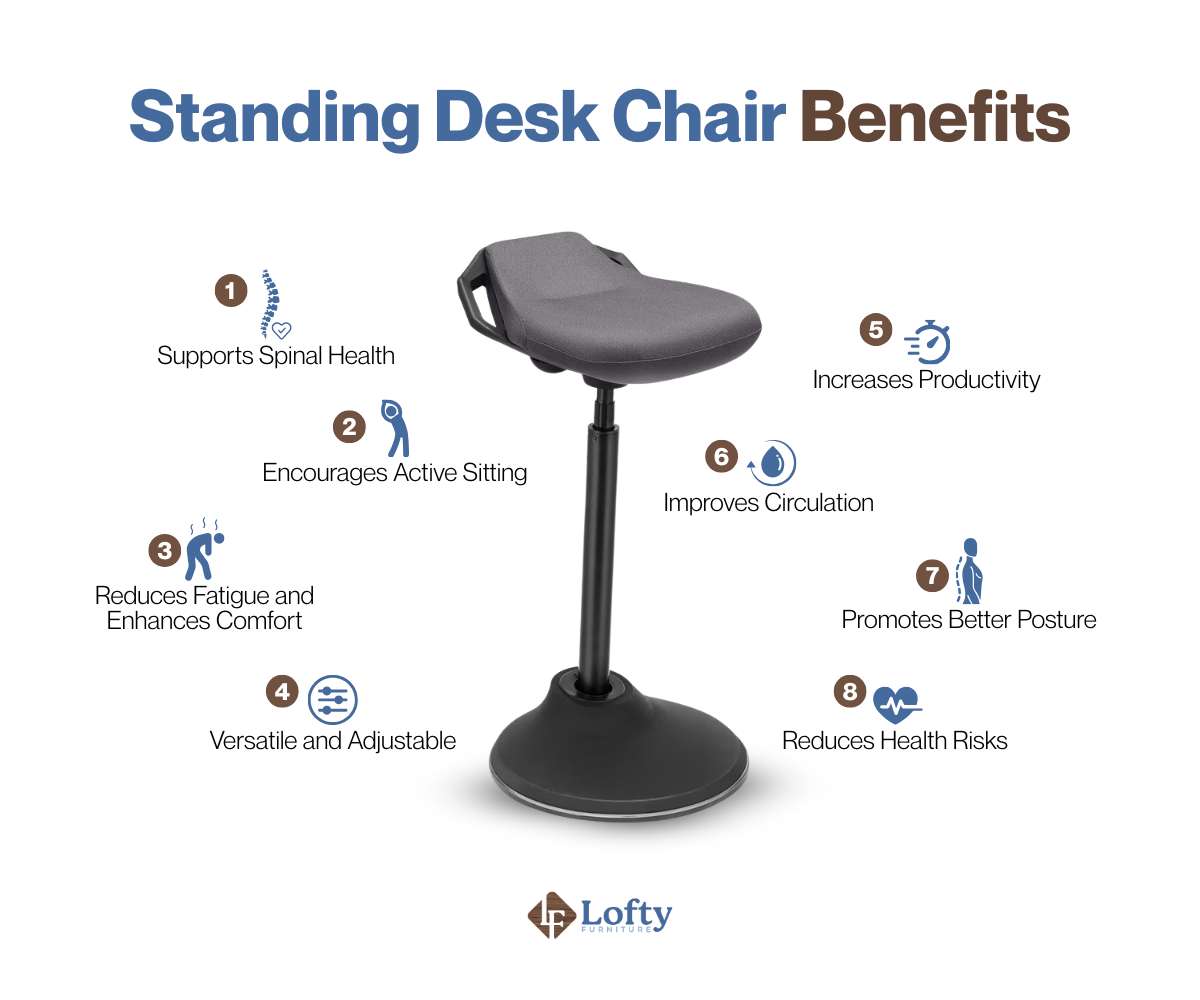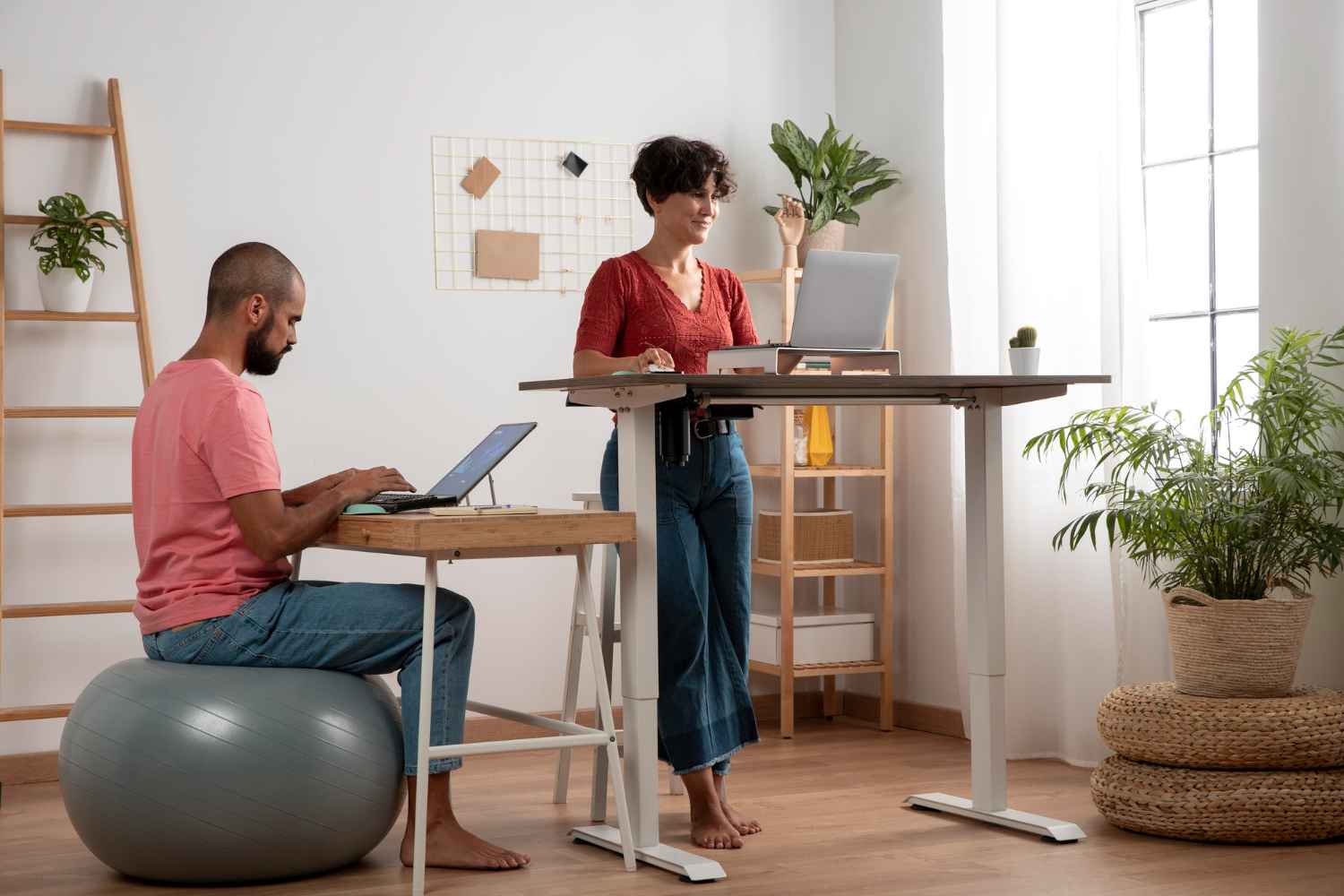With more people working from home than ever before, creating a comfortable and efficient home office is essential for both productivity and well-being. One often-overlooked aspect of this setup is choosing the right chair for your standing desk. While standing desks are known for promoting better posture and reducing the risks of prolonged sitting, the best standing desk chair can provide the support you need when it’s time to sit down. Whether you’re transitioning between sitting and standing throughout the day or simply need a moment to relax, the right chair can make all the difference.
Key Takeaways:
- A good standing desk chair encourages movement, helping reduce fatigue and improve circulation, which can make you feel more comfortable and focused.
- Look for a chair that allows you to adjust the seat height, tilt, and lumbar support to match your body and desk height for better posture and comfort.
- Choose a chair that suits your work style, whether it’s a wobble stool for movement or a perch stool for a semi-standing position, to improve your posture and comfort.
In this article, we’ll explore the key factors to consider when selecting the perfect standing desk chair, helping you create a workspace that supports both your body and your work style.
Why Choosing the Right Standing Desk Chair Matters
Traditional sitting for extended periods is linked to numerous health risks, including increased risk of obesity, heart disease, and type 2 diabetes. While standing desks offer an alternative, prolonged standing can also lead to fatigue, joint stress, and circulatory issues, as documented in ergonomic research.
A standing desk chair addresses these challenges by encouraging active sitting, promoting subtle movements that engage core muscles and improve circulation. It can also significantly reduce lower back pain by supporting proper posture and reducing spinal strain. Moreover, active sitting can enhance focus and productivity by keeping the body and mind engaged, making it an essential component of a healthy and efficient ergonomic setup.

Types of Standing Desk Chairs
Different types of chairs cater to various work styles, from active sitting to posture support. Here’s a breakdown of the most common standing desk chair types:
Active Sitting Chairs
Designed to promote constant micro-movements, active sitting chairs such as wobble stools and balance boards help engage core muscles and improve circulation. These options are great for users who want to stay dynamic while working, reducing stiffness and encouraging better posture.
Perch Stools
Perch stools support a semi-standing position, making them ideal for use with adjustable desks. They reduce pressure on the lower back and legs while keeping the body in an open, upright posture. Their ergonomic design allows for quick transitions between sitting and standing, enhancing flexibility and comfort.
Matt Little, founder of Festoon House, notes:
“Ergonomic stools are a great option since they let you perch at various heights, keeping your core engaged, especially if they have a tilting seat to promote active sitting. Leaning chairs act as a halfway point between sitting and standing, taking some weight off your feet while keeping you upright.”
Kneeling Chairs
Kneeling chairs position the body at a forward-leaning angle, promoting better spinal alignment and reducing lower back strain. They shift weight distribution to the shins, which can improve posture over time. However, they may not be comfortable for prolonged use and aren’t suited for everyone.
Saddle Chairs
Commonly used in medical and creative fields, saddle chairs encourage proper hip alignment. They help maintain a natural spinal curve and are particularly beneficial for users who need mobility while seated. While ergonomic, they may take some time to adjust to.
Matt Little adds:
“Saddle chairs, shaped like a horse saddle, open up your hip angle and encourage good posture.”

Key Features to Look for in a Standing Desk Chair
These features ensure that the chair complements your standing desk setup and promotes a healthy, productive work environment.
Adjustability and Comfort
Look for a chair with adjustable seat height, tilt, and lumbar support to customize it for your body and desk, promoting proper posture and comfort. High-density foam, breathable mesh, and contoured backrests reduce discomfort, pressure points, and overheating, making long hours more comfortable.
Durability and Stability
Durability is key for long-term use. Choose a chair with a stable, wide base that prevents tipping, especially when shifting positions. Chairs made from high-quality materials like steel or reinforced nylon are built to last. Be sure to check weight capacity ratings to ensure the chair can safely support you.
Mobility
A chair with swivel and caster features adds flexibility to your workspace. A 360-degree swivel allows for easy turning, while smooth-rolling casters make it effortless to move across different floor types. Make sure the casters are suitable for your floor surface to avoid damage or resistance.
As someone who spends a lot of time at a desk, Jason Rowe shares:
“If you’re using the chair for short periods, look for something with a lightweight build and cushioned seat to prevent fatigue. I’ve found that using a chair with these features has helped improve my own productivity by 18%, since I no longer feel the need to take breaks as frequently.”
Enhance your ergonomic setup beyond a standing desk chair. Explore our selection of modern ergonomic chairs for ultimate comfort and support.
How to Match Your Chair with Your Standing Desk

When setting up your standing desk chair, the first thing to consider is desk height compatibility. Your chair should be adjustable so that you can find a height where your forearms are parallel to the ground while typing, and your feet can rest flat on the floor. If your desk is too high or too low, it can lead to discomfort and strain. A chair with a wide range of height adjustments gives you the flexibility to match your chair to your desk and maintain a comfortable working posture.
Next, focus on ergonomic alignment to keep your spine in a neutral position and avoid any strain. Your chair should support the natural curve of your back, especially in the lumbar region, so you’re not slouching. Make sure your knees are at a 90-degree angle with your thighs parallel to the floor, and if needed, use a footrest to support your feet. When adjusting the chair, set the armrests at a height where your arms are relaxed and your shoulders aren’t hunched. By making these simple adjustments, you’ll promote better posture, reduce discomfort, and be able to work more comfortably throughout the day.
Conclusion: Finding the Best Standing Desk Chair For You
Choosing the best standing desk chair is an investment in your health and productivity. By carefully considering the key features and exploring different types, you can create a workspace that supports your well-being and enhances your work experience. Remember that the ideal chair is one that fits your body, work style, and personal preferences, allowing for a comfortable and dynamic work environment.
FAQs
Can a standing desk chair replace a regular office chair?
Yes, a standing desk chair can replace a regular office chair, especially if you use a standing desk. However, it’s essential to choose a chair that provides adequate support and adjustability for both sitting and semi-standing positions.
Are standing desk chairs suitable for people with back pain?
Many standing desk chairs are designed to alleviate back pain by promoting better posture and reducing spinal strain. Chairs with adjustable lumbar support, such as kneeling or saddle chairs, can be particularly beneficial.
How tall should a standing desk chair be for optimal ergonomics?
The ideal height of a standing desk chair depends on your height and the height of your standing desk. Generally, your feet should be flat on the floor, your knees should be at a 90-degree angle, and your hips should be slightly higher than your knees when seated.
Do standing desk chairs help with weight loss or calorie burning?
While standing desk chairs, especially active sitting chairs, can encourage movement and increase calorie expenditure compared to traditional sitting, they are not a primary tool for weight loss. The subtle movements and postural changes can contribute to a slight increase in calorie burn, but the effects are generally minimal.
